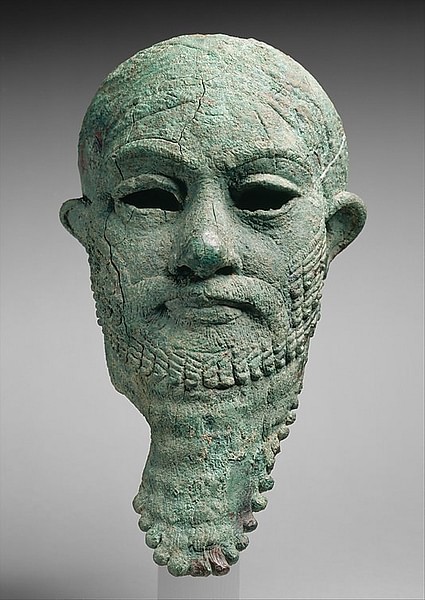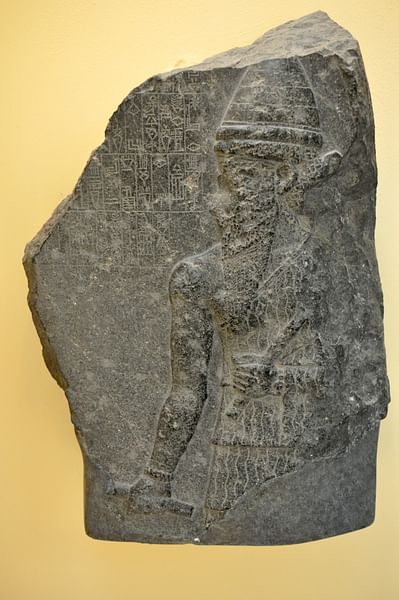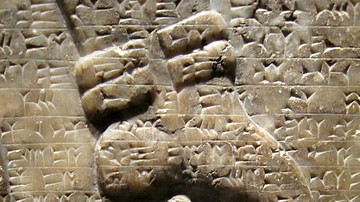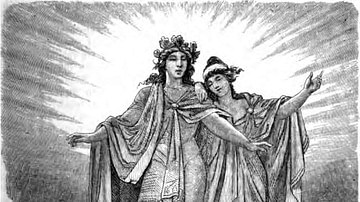
Mesopotamian Naru Literature was a literary genre, first appearing around the 2nd millennium BCE, which featured a famous person (usually a king) from history as the main character in a story that most often concerned humanity's relationship with the gods. These stories became very popular and, in time, seem to have replaced the actual historical events in the minds of the people.
Two examples of naru literature - The Legend of Sargon, which came to be accepted as the king's authentic autobiography, and The Curse of Agade, dealing with Sargon's grandson Naram-Sin - were so completely accepted as authentic history that even the great scholar L.W. King wrote of them as such in his 1910 CE work, A History of Sumer and Akkad. The stories that comprised naru literature were highly entertaining and, because they centered on well-known figures from the past, were instantly engaging and encouraged belief in their historical authenticity.
The most famous example of Naru Literature, although it departs significantly from the form in many respects, is The Epic of Gilgamesh (written c. 2150-1400 BCE from pre-existing tales). In this work, the historical king of Uruk, Gilgamesh, is given a transcendent, mythical role as the central character searching for meaning in life.
Development of the Genre
The names of the great Akkadian kings were well known throughout Mesopotamia all the way down from Sargon's reign (2334-2279 BCE) to the fall of the Assyrian Empire in 612 BCE. The copies of such stories found at sites such as Nineveh and Mari attest to their popularity in ancient Mesopotamia, and it is highly unlikely that the ancient people who heard them gave a thought as to whether they were historically true accounts; they were simply good stories with an important message.
The scholar O.R. Gurney defines naru literature in his work The Cuthaean Legend of Naram-Sin:
A naru was an engraved stele, on which a king would record the events of his reign; the characteristic features of such an inscription are a formal self-introduction of the writer by his name and titles, a narrative in the first person, and an epilogue usually consisting of curses upon any person who might in the future deface the monument and blessings upon those who should honour it. The so-called "naru literature" consists of a small group of apocryphal naru-inscriptions, composed probably in the early second millennium B.C., but in the name of famous kings of a bygone age. A well-known example is the Legend of Sargon of Akkad. In these works the form of the naru is retained, but the matter is legendary or even fictitious. (93)
Scholars disagree whether such stories should rightly be called "naru literature" or "fictitious autobiography". Whichever term one uses, the works purposefully represent themselves as first-person accounts of an event of significance from which an audience is supposed to learn some important information, whether the "truth" of historical events, a religious moral, or simply some lesson which was thought useful to those hearing the tales. The term "naru literature" comes from "naru" which is explained by scholar Gerdien Jonker:
The word naru is used as a name for various objects, originally boundary stones, memorial stones and monuments. Two sorts of inscribed objects received the designation naru at the dawn of the second millennium: tablets accompanying presents and tablets used for building inscriptions. At the end of the third millennium the naru chiefly played a part in religious transactions; at the beginning of the second millennium it was to become not only actually but also symbolically the bearer of memory. (90)
Inscriptions on stele and buildings was long a practice of the Mesopotamian kings by the time naru literature developed. The earliest form of writing in Mesopotamia (c. 3500-3000 BCE) was pictograms – symbols that represented objects – which served as memory aids. They helped in remembering such things as how much grain had gone to which destination or how many sheep were needed for events like sacrifices in the temples. These pictographs were impressed onto wet clay which was then dried, and these became official records of commerce.
When writing moved from pictograms to phonograms, literature became possible. The kings could now record the glory of their reigns for posterity and, of course, did so. The king's inscriptions always focused on the gods and the monarch's own great deeds and addressed either a deity or a distant future audience. Naru literature took the form of the earlier naru inscriptions and changed them into stories that concerned the king's relationship with the gods and his people and were addressed to a contemporary audience. Regarding this, Gerdien Jonker writes:
There are a few differences to be mentioned between the naru monuments and the literary genre deriving from them: a. The intention of the objects was chiefly communication between god and man; in the literary genre the speaker exclusively addresses other people. b. In the first case the text was written on an object (statue, stele, building, building tablet, etc); in the second, the writer only pretends that the text is written on an object. (95)

Naru Literature and Memory
The best example of this is the 2nd millennium BCE tale, The Legend of Cutha, featuring Naram-Sin (which is naru literature) as contrasted with an actual naru inscription. The story of Naram-Sin (r. 2261-2224 BCE) is told in the style of an inscription but deviates significantly. The following are the opening lines of a naru inscription by King Lugalzagesi (r. c. 2350 BCE) who was Sargon of Akkad's predecessor:
Lugalzagesi, king of Uruk,
king of the nation,
incantation-priest of An,
lumah-priest of Nisaba,
son of U-U, the ruler of Umma
and lumah-priest of Nisaba,
looked upon truly
by An as the king of all the lands.
The opening of The Legend of Cutha, on the other hand, begins thusly:
Open the tablet box and read the stele
that I, Naram-Sin, descendant of Sargon
inscribed and left behind for posterity.
The king of Uruk disappeared.
Enmerkar disappeared.
Enmerkar, king of Uruk, ruler of the land
[Some period of time] passed.
[Some period of time] went by.
The naru inscriptions relate the story of the king's reign and triumphs; the naru literature often tells the story of the king's struggles and failure, even if the events never happened. In The Legend of Cutha, for example, Naram-Sin is faced with an invading hoard of seemingly super-human creatures. When he asks the gods for advice in opposing them, he is told that he should do nothing. He ignores the will of the gods, however, and decides to rely on his own judgment. He sends out a massive military force that is slaughtered by the invaders and does so two more times before he realizes he is doing something wrong in the eyes of the gods since, clearly, they are not favoring his cause. He humbles himself, seeks their guidance, and learns that the gods had plans to destroy the invaders themselves and did not need, nor want, Naram-Sin's interference. He comes to understand that one should trust the will of the gods instead of following the counsel of one's own heart.
The poem ends with Naram-Sin directly addressing future rulers, telling them to trust the gods, heed the message of his story, and not make the same mistakes that he did. This is quite a different kind of story than those of kings like Lugalzagesi (and Naram-Sin's actual inscriptions) that told only of the great accomplishments of their reigns, their military campaigns, and temples and cities built by their decree. The naru literature was not interested in relating what actually did happen but in creating a tale of what could have happened - and what could happen again in the present - if one did not recognize one's proper place in the universe and behave accordingly. Gerdien Jonker writes:
What mattered in the naru literature was the retaining of memory, condensed into the enduring name of the "sender". It was also a matter of preserving one's own memory, of making oneself live on in the form of one's own name, which was bound up with the memory of one's own deeds. Names had to resound because people wished for them to be invoked after death. (96)
This same theme runs throughout The Epic of Gilgamesh in which the central character is so traumatized by the loss of his friend, Enkidu, that he must find some ultimate meaning for the human condition which he finds characterized by too brief a stay on earth, the certainty of death, and the mystery of what comes afterwards. The Epic of Gilgamesh departs from the form of Naru Literature in that it is told in the third person and the characters are far more fully developed than they are in other Naru works. Even so, it does fit the basic pattern in that it features a king attested to historically whose life is reimagined in order to relate an important message to an audience.
Conclusion
Since the naru literature is largely anonymous, the writers must have staked their immortality on the popularity of their tales without needing to attach their names to their work (although it is entirely possible they did so and the original tablets have simply been lost). The author of the later version of Gilgamesh is known by name (Shin-Leqi-Unninni, who wrote c. 1300-1000 BCE in or around Babylon) but this is the exception, not the rule.
All the authors seem to have had the same focus, however, of preserving the past and relating vital cultural values through the creation of entertaining and memorable tales. When Jonker writes above about "the retaining of memory", it should be recognized that it was not necessarily the memory of what had happened in the past that was important to the writers of the naru literature but that there had been a past worth remembering.
Jonker states, "It should be made clear that the ancient writers were not aiming to deceive with their literary creations" (95). They were instead trying to preserve their past in a form they felt could help people in the present. An inscription of the great deeds of a king who conquered many cities and slaughtered many people was fine for that particular king but not much use to the people who lived under him. Naru literature, on the other hand, provided the people with entertaining stories they could learn from, remember, and make use of in their daily lives.





